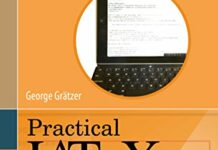
Ebook Info
- Published: 2002
- Number of pages: 663 pages
- Format: PDF
- File Size: 46.82 MB
- Authors: George Grätzer
Description
Grätzer’s ‘General Lattice Theory’ has become the lattice theorist’s bible. Now we have the second edition, in which the old testament is augmented by a new testament. The new testament gospel is provided by leading and acknowledged experts in their fields. This is an excellent and engaging second edition that will long remain a standard reference. –MATHEMATICAL REVIEWS
User’s Reviews
Editorial Reviews: Review “…Grätzer’s ‘General Lattice Theory’ has become the lattice theorist’s bible. Now…we have the second edition, in which the old testament is augmented by a new testament…. The new testament gospel is provided by leading and acknowledged experts in their fields…. Each [of these eight contributions] is itself a gold mine. This is an excellent and engaging second edition that will long remain a standard reference.” ―MATHEMATICAL REVIEWS”Despite the large number of coauthors the style is uniform and the book is well written. As the first edition of this book had a deep influence on the development of lattice theory, I expect that the new edition will continue to hold its leading position among the books on lattice theory.”―ZENTRALBLATT MATH”This second edition of the Gratzer’s book on lattice theory is an expanded and updated form of its first edition. Following the line of first edition, it combines the techniques of an introductory textbook with those of a monograph to introduce the reader to lattice theory and to bring the expert up to date on the most recent developments. . . Author adds eight appendices to record the changes in the superstructure of lattice theory that occurred in the time between the two editions of this book. In the first appendix, the authro reviews the major results of the last 20 years and solutions of the problems proposed in this book. . . Almost 900 exercises form an important part of this book. The bibliography contains over 750 entries. A very detailed index and the Table of Notation should help the reader in finding where a concept or notation was first introduced.”—ANALELE STIINTIFICE ALE UNIVERSITATII From the Back Cover From the first edition: “This book combines the techniques of an introductory text with those of a monograph to introduce the general reader to lattice theory and to bring the expert up to date on the most recent developments. The first chapter, along with a selection of topics from later chapters, can serve as an introductory course covering first concepts, distributive, modular, semimodular, and geometric lattices, and so on. About 900 exercises and almost 130 diagrams help the beginner to learn the basic results and important techniques. The latter parts of each chapter give deeper developments of the fields mentioned above and there are chapters on equational classes (varieties) and free products. More advanced readers will find the almost 200 research problems, the extensive bibliography, and the further topics and references at the end of each chapter of special use.”In this present edition, the work has been significantly updated and expanded. It contains an extensive new bibliography of 530 items and has been supplemented by eight appendices authored by an exceptional group of experts. The first appendix, written by the author, briefly reviews developments in lattice theory, specifically, the major results of the last 20 years and solutions of the problems proposed in the first edition. The other subjects concern distributive lattices and duality (Brian A. Davey and Hilary A. Priestley), continuous geometries (Friedrich Wehrung), projective lattice geometries (Marcus Greferath and Stefan E. Schmidt), varieties (Peter Jipsen and Henry Rose), free lattices (Ralph Freese), formal concept analysis (Bernhard Ganter and Rudolf Wille), and congruence lattices (Thomas Schmidt in collaboration with the author).
Reviews from Amazon users which were colected at the time this book was published on the website:
⭐This is an outstanding book on a field of mathematics which, although very accessible and widely applicable, is not considered as fundamental as I believe it should be. The author writes clearly, providing concise proofs with sound logic, good motivation for the material, discussion of historical development of the subject, and directions for future research. Diagrams are used very well in this text. The exercises are numerous and very illuminating, and very fun! The author provides an extensive bibliography and references results throughout the text.There is something very enticing about the way of thinking used in lattice theory, and in particular, the way Gratzer approaches the subject in this book. Like in most areas of mathematics, a given concept can be viewed in many different ways, and one can study these objects at progressively higher levels of abstraction and generality. What is most remarkable about lattice theory, however, is that these higher levels of abstraction and generality do not become overwhelmingly difficult to comprehend as they develop–something that unfortunately happens in many other areas of mathematics. In particular, I think that algebraic concepts such as congruence relations, equational varieties, and “freeness” are much easier to understand in the context of lattices than in other algebraic structures. However, this is also true of more general mathematical concepts such as the effect of weakening conditions on theorems, searching for counterexamples, finding equivalent formulations of a given condition, and studying properties preserved under maps. This is partly due to the fact that in lattices, much of what is going on can be easily drawn or visualized. For this reason, lattices provide an excellent framework for understanding many of the basic concepts that underly all areas of mathematics.Although the topic of this book is viewed as specialized and esoteric by some mathematicians, I believe that the material it contains is quite universal. Lattices appear in virtually every area of mathematics, and they are especially useful in universal algebra and combinatorics. While this book does not directly talk much about these applications, this book would certainly enrich the knowledge and understanding of people who work in those fields. I would recommend this book to anyone who is serious about algebra or combinatorics as well, as the ways of thinking developed by reading this book and working exercises will prove invaluable in these disciplines. This book also might be useful to beginning graduate students who want to develop their general mathematical maturity in a setting which can be a lot more fun and accessible than other areas of abstract math.As a final note, the binding on the hardcover edition is excellent. I rarely encounter books this well-bound, in a day an age when sometimes even hardback books start falling apart after moderate use.
⭐A very nice book arrived on time.
Keywords
Free Download General Lattice Theory (Second Edition) in PDF format
General Lattice Theory (Second Edition) PDF Free Download
Download General Lattice Theory (Second Edition) 2002 PDF Free
General Lattice Theory (Second Edition) 2002 PDF Free Download
Download General Lattice Theory (Second Edition) PDF
Free Download Ebook General Lattice Theory (Second Edition)




